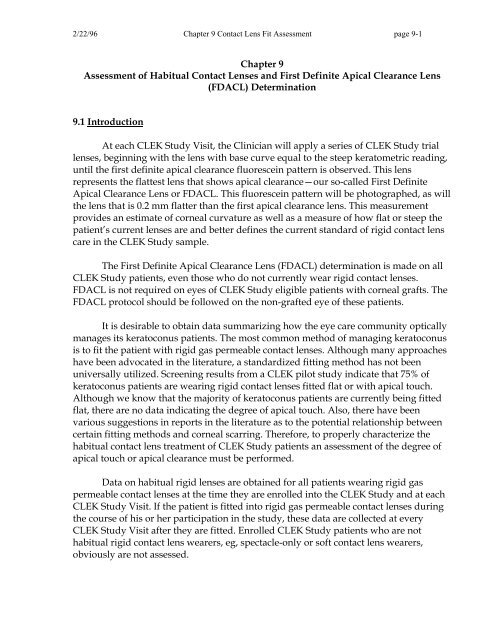OM t of c.iii - Vision Research Coordinating Center - Washington ...
OM t of c.iii - Vision Research Coordinating Center - Washington ...
OM t of c.iii - Vision Research Coordinating Center - Washington ...
Create successful ePaper yourself
Turn your PDF publications into a flip-book with our unique Google optimized e-Paper software.
2/22/96 Chapter 9 Contact Lens Fit Assessment page 9-1<br />
Chapter 9<br />
Assessment <strong>of</strong> Habitual Contact Lenses and First Definite Apical Clearance Lens<br />
(FDACL) Determination<br />
9.1 Introduction<br />
At each CLEK Study Visit, the Clinician will apply a series <strong>of</strong> CLEK Study trial<br />
lenses, beginning with the lens with base curve equal to the steep keratometric reading,<br />
until the first definite apical clearance fluorescein pattern is observed. This lens<br />
represents the flattest lens that shows apical clearance—our so-called First Definite<br />
Apical Clearance Lens or FDACL. This fluorescein pattern will be photographed, as will<br />
the lens that is 0.2 mm flatter than the first apical clearance lens. This measurement<br />
provides an estimate <strong>of</strong> corneal curvature as well as a measure <strong>of</strong> how flat or steep the<br />
patient’s current lenses are and better defines the current standard <strong>of</strong> rigid contact lens<br />
care in the CLEK Study sample.<br />
The First Definite Apical Clearance Lens (FDACL) determination is made on all<br />
CLEK Study patients, even those who do not currently wear rigid contact lenses.<br />
FDACL is not required on eyes <strong>of</strong> CLEK Study eligible patients with corneal grafts. The<br />
FDACL protocol should be followed on the non-grafted eye <strong>of</strong> these patients.<br />
It is desirable to obtain data summarizing how the eye care community optically<br />
manages its keratoconus patients. The most common method <strong>of</strong> managing keratoconus<br />
is to fit the patient with rigid gas permeable contact lenses. Although many approaches<br />
have been advocated in the literature, a standardized fitting method has not been<br />
universally utilized. Screening results from a CLEK pilot study indicate that 75% <strong>of</strong><br />
keratoconus patients are wearing rigid contact lenses fitted flat or with apical touch.<br />
Although we know that the majority <strong>of</strong> keratoconus patients are currently being fitted<br />
flat, there are no data indicating the degree <strong>of</strong> apical touch. Also, there have been<br />
various suggestions in reports in the literature as to the potential relationship between<br />
certain fitting methods and corneal scarring. Therefore, to properly characterize the<br />
habitual contact lens treatment <strong>of</strong> CLEK Study patients an assessment <strong>of</strong> the degree <strong>of</strong><br />
apical touch or apical clearance must be performed.<br />
Data on habitual rigid lenses are obtained for all patients wearing rigid gas<br />
permeable contact lenses at the time they are enrolled into the CLEK Study and at each<br />
CLEK Study Visit. If the patient is fitted into rigid gas permeable contact lenses during<br />
the course <strong>of</strong> his or her participation in the study, these data are collected at every<br />
CLEK Study Visit after they are fitted. Enrolled CLEK Study patients who are not<br />
habitual rigid contact lens wearers, eg, spectacle-only or s<strong>of</strong>t contact lens wearers,<br />
obviously are not assessed.
















